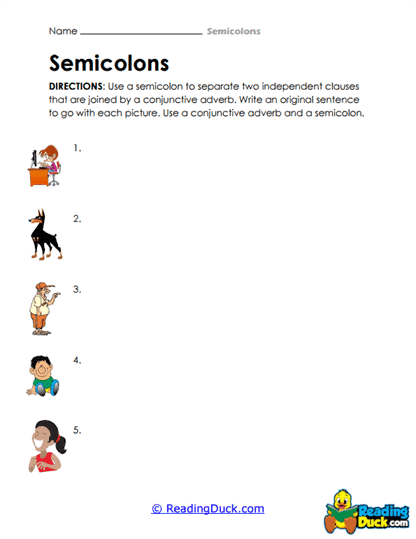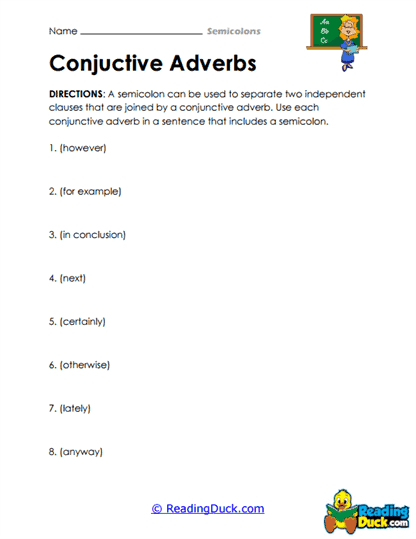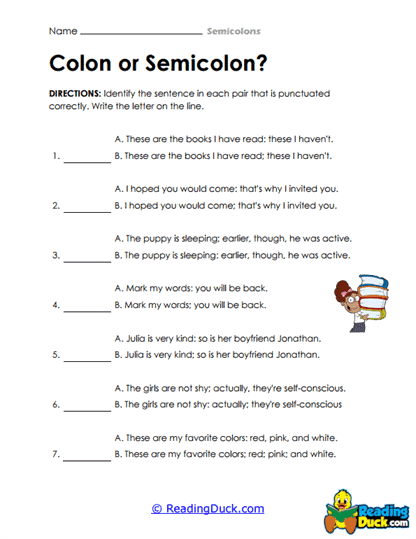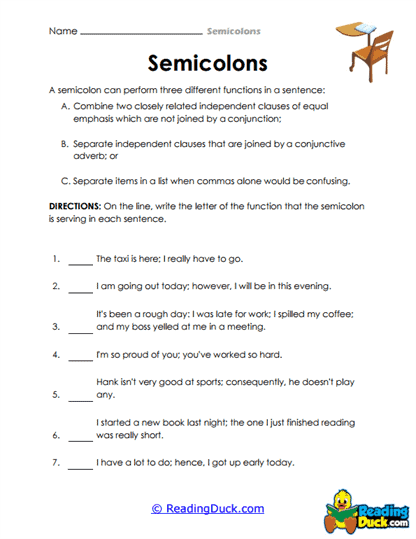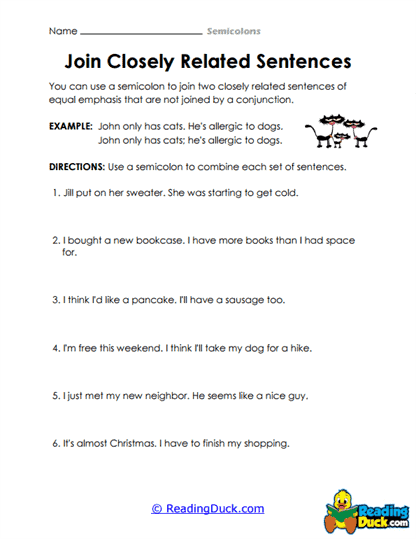Semicolons Worksheets
About Our Semicolon Worksheets
The Semicolons Worksheets collection is part of the Punctuation category within the Skills section and is designed to help students master the correct use of semicolons in writing. Semicolons are an often misunderstood but essential punctuation mark, used to create clearer sentence structures by linking closely related independent clauses and organizing complex lists. These worksheets offer a structured approach for students to practice applying semicolons, reinforcing the key rules governing their use in various writing contexts.
The worksheets are available in PDF format, which makes them easy to view, download, and print for use in different learning environments, whether at school or home. Additionally, each worksheet includes a downloadable answer key, allowing students and educators to review their work easily and identify areas for improvement. This format supports independent learning and helps students develop their punctuation skills in an organized and accessible way.
Understanding Semicolons: A Comprehensive Overview
Semicolons are a punctuation mark (;) that serve a unique purpose in writing, distinct from both commas and periods. While semicolons may seem complex, they are actually a powerful tool for structuring sentences and enhancing clarity when used correctly. Let’s break down what semicolons are and how they function in writing.
What Is a Semicolon?: A semicolon is a punctuation mark that links two closely related independent clauses or separates items in a list when the list items contain commas. It is stronger than a comma but less final than a period, making it a middle ground between these two marks.
When to Use Semicolons: Knowing when to use semicolons correctly is crucial for creating more complex sentence structures. Semicolons are particularly useful in the following cases:
-
- To Link Independent Clauses: When two independent clauses are closely related in meaning and could stand as separate sentences, a semicolon can be used to link them without the need for a conjunction like “and” or “but.” For example:
- I have a big exam tomorrow; I can’t go to the party tonight.
- To Link Independent Clauses: When two independent clauses are closely related in meaning and could stand as separate sentences, a semicolon can be used to link them without the need for a conjunction like “and” or “but.” For example:
-
- In Complex Lists: Semicolons are also used to separate items in a list when the list items themselves contain commas, preventing confusion between the elements. For example:
- On our trip, we visited New York, New York; Paris, France; and Tokyo, Japan.
- In Complex Lists: Semicolons are also used to separate items in a list when the list items themselves contain commas, preventing confusion between the elements. For example:
The Structure of Sentences with Semicolons: Semicolons link independent clauses that are thematically related but can stand alone as complete sentences. Unlike commas, semicolons don’t rely on conjunctions to connect thoughts, allowing writers to form more complex sentence structures without repeating conjunctions unnecessarily.
Examples of Correct and Incorrect Semicolon Usage:
-
- Correct:
- I want to travel the world; I just need to save more money first.
- The team includes John, a software developer; Sarah, a graphic designer; and Mike, a project manager.
- Correct:
-
- Incorrect:
- I went to the store; and I bought some groceries. (The semicolon is unnecessary because of the conjunction “and.”)
- She likes pizza; but she doesn't like burgers. (The semicolon is incorrect because “but” is a conjunction.)
- Incorrect:
Understanding these basic principles of semicolons helps students avoid common errors while making their writing more sophisticated and varied.
Different Functions of Semicolons
Semicolons serve multiple functions in writing, enhancing sentence variety and clarity. Learning how to use semicolons in different contexts allows students to create more nuanced and effective writing. Below are the main functions of semicolons with examples to illustrate their use.
Linking Independent Clauses: One of the primary uses of semicolons is to connect independent clauses that are related in meaning but could stand alone as separate sentences. This use of the semicolon shows a close connection between two ideas without needing a conjunction.
-
- The sun is setting; the sky is turning a deep shade of orange.
Separating Items in a Complex List: Semicolons are also used to organize lists where items themselves contain commas. Using semicolons in these lists prevents confusion between the elements by clearly separating each item.
-
- The conference was attended by participants from Boston, Massachusetts; Austin, Texas; and San Francisco, California.
Semicolons in Conjunction with Transition Words: Semicolons are used before transition words like “however,” “therefore,” or “nonetheless” when these words link two independent clauses. The semicolon is placed before the transition word, and a comma follows it.
-
- The weather forecast predicted rain; however, the skies remained clear all day.
Avoiding Run-on Sentences: Semicolons help students avoid run-on sentences by allowing them to separate clauses without the need for a period, which might break the flow of their writing. This function helps maintain the continuity of ideas in more complex writing.
-
- She was eager to start her new job; her excitement was contagious.
Each of these functions allows students to improve their sentence variety and writing sophistication, making their work more engaging and clear.
How Learning About Semicolons Improves Literacy Skills
Semicolons play a key role in developing students’ literacy by giving them tools to structure their writing more effectively. Mastering semicolons not only improves writing but also enhances reading comprehension and communication skills.
- Enhancing Writing Structure: Learning how to use semicolons allows students to structure their sentences with more complexity. Instead of relying on simple sentence patterns, students can use semicolons to connect related ideas without using repetitive conjunctions, which elevates the quality of their writing.
- Improving Clarity in Writing: Semicolons help avoid confusion, especially in complex lists where commas alone could cause ambiguity. By separating items clearly, semicolons ensure that the reader understands each part of the sentence, improving overall clarity and communication.
- Developing Reading Comprehension: When students understand how semicolons work, they become more adept at identifying relationships between ideas when reading. Recognizing the use of semicolons in texts improves their comprehension of complex sentences and the nuances of language.
- Strengthening Formal Writing: In academic and formal writing, semicolons are a valuable tool for creating more sophisticated sentence structures. By mastering the use of semicolons, students can write more professionally, improving their skills in essays, reports, and research papers.
Mastering semicolons builds students' overall literacy and provides them with greater control over the complexity and clarity of their written work.
Engaging Activities to Reinforce Semicolon Usage
To help students practice semicolon usage and make learning more engaging, educators can incorporate various interactive activities. These activities are suitable for students in grades 4 through 8, depending on their literacy level and familiarity with punctuation rules.
- Sentence Combining Challenge: Provide students with pairs of independent clauses and ask them to combine the clauses using semicolons. This activity encourages students to identify where semicolons can be used and helps them practice constructing complex sentences.
- List Puzzle: Give students a list of items, some of which contain commas, and ask them to rewrite the list using semicolons to separate the items clearly. This reinforces how semicolons function in lists and prevents confusion between elements.
- Semicolon Story Writing: Challenge students to write a short story that includes at least five semicolons. This activity encourages creativity while ensuring that students practice using semicolons in various sentence structures.
- Peer Editing for Semicolons: In small groups, students can exchange their writing and look for opportunities to add semicolons where appropriate. This peer-editing exercise helps students recognize when semicolons are needed and provides them with real-time feedback from their peers.
- Semicolon Scavenger Hunt: Provide students with passages from books, articles, or essays and ask them to find examples of semicolons. This activity teaches students to recognize semicolons in context and understand their use in published writing.
These activities make learning semicolons more interactive and enjoyable, encouraging students to practice using them in meaningful ways.
The Importance of Semicolons in Writing
In conclusion, semicolons are a powerful punctuation mark that helps students organize their writing with clarity and precision. By linking independent clauses and separating complex lists, semicolons enhance the structure of sentences and allow for greater sophistication in writing.
The Semicolons Worksheets collection provides students with the tools they need to understand and apply this punctuation mark correctly. Through consistent practice, students can develop confidence in their ability to use semicolons, improving their overall writing skills and preparing them for more advanced academic work.
Mastering semicolons not only strengthens students' writing but also deepens their understanding of how punctuation shapes meaning and clarity in written language.
